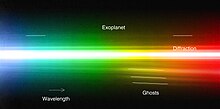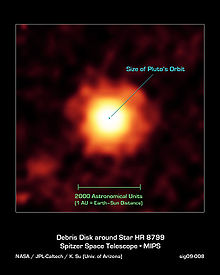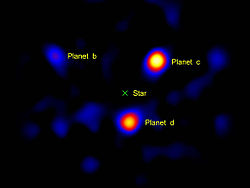HR 8799
File:Benjamin Zuckerman HR 8799 planets image Dec. 2010.jpg HR 8799 (center blob) with HR 8799e (right), HR 8799d (lower right), HR 8799c (upper right), HR 8799b (upper left) from W. M. Keck Observatory | |
| Observation data Epoch J2000.0 Equinox J2000.0 (ICRS) | |
|---|---|
| Constellation | Pegasus |
| Right ascension | 23h 07m 28.7150s[1] |
| Declination | +21° 08′ 03.302″[1] |
| Apparent magnitude (V) | 5.964[1] |
| Characteristics | |
| Spectral type | kA5 hF0 mA5 V; λ Boo[2][3] |
| U−B color index | −0.04[4] |
| B−V color index | 0.234[1] |
| Variable type | Gamma Doradus variable[1] |
| Astrometry | |
| Radial velocity (Rv) | −11.5 ± 2[1] km/s |
| Proper motion (μ) | RA: 107.93 ± 0.60[5] mas/yr Dec.: −49.63 ± 0.46[5] mas/yr |
| Parallax (π) | 25.38 ± 0.70 mas[5] |
| Distance | 129 ± 4 ly (39 ± 1 pc) |
| Absolute magnitude (MV) | 2.98 ± 0.08[2] |
| Details | |
| Mass | 1.47 ± 0.30[2] M☉ |
| Radius | 1.34 ± 0.05[2] R☉ |
| Luminosity (bolometric) | 4.92 ± 0.41[2] L☉ |
| Surface gravity (log g) | 4.35 ± 0.05[2] cgs |
| Temperature | 7430 ± 75[2] K |
| Metallicity [Fe/H] | −0.47 ± 0.10[2][note 1] dex |
| Rotational velocity (v sin i) | 37.5 ± 2[2] km/s |
| Age | 30+20 −10 million[6] years |
| Other designations | |
| Database references | |
| SIMBAD | data |
| Exoplanet Archive | data |
HR 8799 is a young (~30 million-year-old) main sequence star located 129 light years (39 parsecs) away from Earth in the constellation of Pegasus, with roughly 1.5 times the Sun's mass and 4.9 times its luminosity. It is part of a system that also contains a debris disk and at least four massive planets.[6] It, along with Fomalhaut b, were the first extrasolar planets whose orbital motion was confirmed via direct imaging. The designation HR 8799 is the star's identifier in the Bright Star Catalogue. The star is a Gamma Doradus variable: its luminosity changes because of non-radial pulsations of its surface. The star is also classified as a Lambda Boötis star, which means its surface layers are depleted in iron peak elements.[2] This may be due to the accretion of metal-poor circumstellar gas.[7] It is the only known star which is simultaneously a Gamma Doradus variable, a Lambda Boötis type, and a Vega-like star (a star with excess infrared emission caused by a circumstellar disk).[8]
Stellar properties
The star HR 8799 is a member of the Lambda Boötis (λ Boo) class, a group of peculiar stars with an unusual lack of metals—elements heavier than hydrogen and helium—in their upper atmosphere. Because of this special status, stars like HR 8799 have a very complex spectral type. The luminosity profile of the Balmer lines in the star's spectrum, as well as the star's effective temperature, best match the typical properties of an F0 V star. However, the strength of the calcium II K absorption line and the other metallic lines are more like those of an A5 V star. The star's spectral type is therefore written as kA5 hF0 mA5 V; λ Boo.[2][3]
Age determination of this star shows some variation based on the method used. Statistically, for stars hosting a debris disk, the luminosity of this star suggests an age of about 20–150 million years. Comparison with stars having similar motion through space gives an age in the range 30–160 million years. Given the star's position on the Hertzsprung–Russell diagram of temperature versus luminosity, it has an estimated age in the range of 30–1,128 million years. λ Boötis stars like this are generally young, with a mean age of a billion years. More accurately, asteroseismology also suggests an age of approximately a billion years.[9] However, this is disputed because it would make the planets become brown dwarfs to fit into the cooling models. Brown dwarfs would not be stable in such a configuration. The best accepted value for an age of HR8799 is 30 million years, consistent with being a member of the Columba Association co-moving group of stars.[10]
Detailed analysis of the star's spectrum reveals that it has a slight overabundance of carbon and oxygen compared to the Sun (by approximately 30% and 10% respectively). While some Lambda Boötis stars have sulfur abundances similar to that of the Sun, this is not the case for HR 8799; the sulfur abundance is only around 35% of the solar level. The star is also poor in elements heavier than sodium: for example, the iron abundance is only 28% of the solar iron abundance.[11] Asteroseismic observations of other pulsating Lambda Boötis stars suggest that the peculiar abundance patterns of these stars are confined to the surface only: the bulk composition is likely more normal. This may indicate that the observed element abundances are the result of the accretion of metal-poor gas from the environment around the star.[12]
Astroseismic analysis using spectroscopic data indicates that the rotational inclination of the star is constrained to be greater than or approximately equal to 40°. This contrasts with the planet's orbital inclinations, which are in roughly the same plane at an angle of about 20° ± 10°. Hence, there may be an unexplained misalignment between the rotation of the star and the orbits of its planets.[13] Observation of this star with the Chandra X-ray Observatory indicates that it has a weak level of magnetic activity, but the X-ray activity is much higher than that of an A-type star like Altair. This suggests that the internal structure of the star more closely resembles that of an F0 star. The temperature of the corona is about 3.0 million K.[14]
Planetary system
On November 13, 2008, Christian Marois of the National Research Council of Canada's Herzberg Institute of Astrophysics and his team (David Lafrenière and René Doyon, Université de Montréal) announced they had directly observed three planets orbiting the star with the Keck and Gemini telescopes in Hawaii,[8][15][16][17] in both cases employing adaptive optics to make observations in the infrared.[note 2] A precovery observation of the outer 3 planets was later found in infrared images obtained in 1998 by the Hubble Space Telescope's NICMOS instrument, after a newly developed image-processing technique was applied.[18] Further observations in 2009–2010 revealed the fourth giant planet orbiting inside the first three planets.[6]
The outer planet orbits inside a dusty disk like the Solar Kuiper belt. It is one of the most massive disks known around any star within 300 light years of Earth, and there is room in the inner system for terrestrial planets.[16] There is an additional debris disk just inside the orbit of the innermost planet.[6]
The orbital radii of planets e, d, c and b are 2 to 3 times those of Jupiter, Saturn, Uranus, and Neptune, respectively. Because of the inverse square law relating radiation intensity to distance from the source, comparable radiation intensities are present at distances = 2.2 times farther from HR 8799 than from the Sun, meaning that corresponding planets in the solar and HR 8799 systems receive similar amounts of stellar radiation.[6]
These objects are near the upper mass limit for classification as planets; if they exceeded 13 Jupiter masses, they would be capable of deuterium fusion in their interiors and thus qualify as brown dwarfs under the definition of these terms used by the IAU's Working Group on Extrasolar Planets.[19] If the mass estimates are correct, the HR 8799 system is the first multiple-planet extrasolar system to be directly imaged.[15] The orbital motion of the planets is in an anticlockwise direction and was confirmed via multiple observations dating back to 1998.[8] The system is more likely to be stable if the planets "e", "d" and "c" are in a 4:2:1 resonance, which would imply that the orbit the planet d has an eccentricity exceeding 0.04 in order to match the observational constraints. Planetary systems with the best-fit masses from evolutionary models would be stable if the outer three planets are in a 1:2:4 orbital resonance (similar to the Laplace resonance between Jupiter's inner three Galilean satellites: Io, Europa and Ganymede as well as three of the planets in the Gliese 876 system).[6] However, it is now believed that planet b is not in resonance with the other 3 planets. If confirmed, the HR 8799 planetary system would be the second extrasolar system to be observed with multiple resonances. The 4 planets are still glowing red hot due to their young age and are larger than Jupiter and over time they will cool and shrink to the size of 0.8 to 1.0 Jupiter radii.
The broadband photometry of planets b, c and d has shown that there may be significant clouds in their atmospheres, while the infrared spectroscopy of planets b and c pointed to non-equilibrium CO/CH4 chemistry.[6]

| Companion (in order from star) |
Mass | Semimajor axis (AU) |
Orbital period (years) |
Eccentricity | Inclination | Radius |
|---|---|---|---|---|---|---|
| e | 7+3 −2 MJ |
~ 14.5±0.5 | ~ 45 | ? | — | — |
| d | 7+3 −2 MJ |
~ 24 | ~ 100 | >0.04[22][note 3] | — | — |
| c | 7+3 −2 MJ |
~ 38 | ~ 190 | ? | — | — |
| b | 5+2 −1 MJ |
~ 68 | ~ 460 | ? | — | — |
| Dust disk | 75 AU | — | — | |||
Debris disk

In January 2009 the Spitzer Space Telescope obtained images of the debris disk around HR 8799. Three components of the debris disk were distinguished:
- Warm dust (T ~ 150 K) orbiting within the innermost planet (e). The inner and outer edges of the this belt are close to 4:1 and 2:1 resonances with the planet.[6]
- A broad zone of cold dust (T ~ 45 K) with a sharp inner edge orbiting just outside the outermost planet (b). The inner edge of this belt is approximately in 3:2 resonance with said planet, similar to Neptune and the Kuiper belt.[6]
- A dramatic halo of small grains originating in the cold dust component.
The halo is unusual and implies a high level of dynamic activity which is likely due to gravitational stirring by the massive planets.[23] The Spitzer team says that collisions are likely occurring among bodies similar to those in our Kuiper Belt and that the three large planets may not yet have settled into their final, stable orbits.[24]
In the photo, the bright, yellow-white portions of the dust cloud come from the outer cold disk. The huge extended dust halo, seen in orange-red, has a diameter of ≈ 2,000 AU. The diameter of Pluto's orbit (≈ 80 AU) is shown for reference as a dot in the centre.[25]
Vortex Coronagraph: Testbed for high-contrast imaging technology

Up until the year 2010, telescopes could only directly image exoplanets under exceptional circumstances. Specifically, it is easier to obtain images when the planet is especially large (considerably larger than Jupiter), widely separated from its parent star, and hot so that it emits intense infrared radiation. However in 2010 a team from NASAs Jet Propulsion Laboratory demonstrated that a vortex coronagraph could enable small scopes to directly image planets.[26] They did this by imaging the previously imaged HR 8799 planets using just a 1.5 m portion of the Hale Telescope.
NICMOS images
In 2009, an old NICMOS image was processed to show a predicted exoplanet around the star HR 8799,[27] thought to be about 130 light-years from Earth.[27]
In 2011, around that same star, three exoplanets were rendered viewable in a NICMOS image taken in 1998, using advanced data processing.[27] The exoplanets were originally discovered with the Keck telescopes and the Gemini North telescope between 2007 and 2010.[27] The image allows the planets' orbits to be analyzed better, since they take many decades, even hundreds of Earth years to orbit their host star.[27] In other words, the NICMOS image is especially useful because it is older.
See also
Notes
- ^ The star is a member of the Lambda Boötis class of peculiar stars, thus the observed abundance may not reflect the abundances of the star as a whole.
- ^ The planets are young and therefore they are still hot and bright in the near-infrared part of the spectrum .
- ^ The eccentricity is given for the case that the planet is in a 2:1 resonance with HR 8799 c, as suggested by stability constraints.
References
- ^ a b c d e f g V* V342 Peg -- Variable Star of gamma Dor type, entry, SIMBAD. Accessed on line November 14, 2008.
- ^ a b c d e f g h i j k Gray, R.O. and Kaye, A.B. (1999). "HR 8799: A Link between γ Doradus Variables and λ Bootis Stars". The Astronomical Journal. 118 (6): 2993–2996. Bibcode:1999AJ....118.2993G. doi:10.1086/301134.
{{cite journal}}: CS1 maint: multiple names: authors list (link) - ^ a b Kaye, A.B.; et al. (1999). "Gamma Doradus Stars: Defining a New Class of Pulsating Variables". PASP. 111 (761): 840–844. arXiv:astro-ph/9905042. Bibcode:1999PASP..111..840K. doi:10.1086/316399.
{{cite journal}}: Explicit use of et al. in:|author=(help) - ^ HR 8799, database entry, The Bright Star Catalogue, 5th Revised Ed. (Preliminary Version), D. Hoffleit and W. H. Warren, Jr., CDS ID V/50. Accessed on line November 14, 2008.
- ^ a b c van Leeuwen, F. (2007). "HIP 114189". Hipparcos, the New Reduction. Retrieved 2008-10-13.
- ^ a b c d e f g h i Attention: This template ({{cite doi}}) is deprecated. To cite the publication identified by doi:10.1038/nature09684, please use {{cite journal}} (if it was published in a bona fide academic journal, otherwise {{cite report}} with
|doi=10.1038/nature09684instead. - ^ Gray, R.O. and Corbally, C.J. (2002). "A Spectroscopic Search for λ Bootis and Other Peculiar A-Type Stars in Intermediate-Age Open Clusters". The Astronomical Journal. 124 (2): 989–1000. Bibcode:2002AJ....124..989G. doi:10.1086/341609.
{{cite journal}}: CS1 maint: multiple names: authors list (link) - ^ a b c Marois, Christian (2008). "Direct Imaging of Multiple Planets Orbiting the Star HR 8799". Science. 322 (5906): 1348–1352. arXiv:0811.2606. Bibcode:2008Sci...322.1348M. doi:10.1126/science.1166585. PMID 19008415.
{{cite journal}}: Unknown parameter|coauthors=ignored (|author=suggested) (help); Unknown parameter|month=ignored (help) - ^ Moya, A.; et al. (2010), "Age determination of the HR8799 planetary system using asteroseismology", Monthly Notices of the Royal Astronomical Society: Letters, 405 (1): L81–L85, arXiv:1003.5796, Bibcode:2010MNRAS.405L..81M, doi:10.1111/j.1745-3933.2010.00863.x
{{citation}}: Unknown parameter|month=ignored (help) - ^ Zuckerman, B.; et al. (2011). "The Tucana/Horologium, Columba, AB Doradus, and Argus Associations: New Members and Dusty Debris Disks". The Astrophysical Journal. 732 (2). arXiv:1104.0284v1. Bibcode:2011ApJ...732...61Z. doi:10.1088/0004-637X/732/2/61.
{{cite journal}}: Unknown parameter|month=ignored (help) - ^ Kozo, Sadakane (2006). "λ Bootis-Like Abundances in the Vega-Like, γ Doradus Type-Pulsator HD 218396". Publications of the Astronomical Society of Japan. 58 (6): 1023–1032. Bibcode:2006PASJ...58.1023S.
- ^ Paunzen, E.; et al. (1998). "Pulsation in λ Bootis stars". Astronomy and Astrophysics. 335: 533–538. Bibcode:1998A&A...335..533P.
{{cite journal}}: Explicit use of et al. in:|author=(help) - ^ Wright, D. J.; et al. (2011), "Determination of the Inclination of the Multi-planet Hosting Star HR 8799 Using Asteroseismology", The Astrophysical Journal Letters, 728 (1), arXiv:1101.1590, Bibcode:2011ApJ...728L..20W, doi:10.1088/2041-8205/728/1/L20
{{citation}}: Unknown parameter|month=ignored (help) - ^ Robrade, J.; Schmitt, J. H. M. M. (2010), "X-ray emission from the remarkable A-type star HR 8799", Astronomy and Astrophysics, 516, arXiv:1004.1318, Bibcode:2010A&A...516A..38R, doi:10.1051/0004-6361/201014027
{{citation}}: Unknown parameter|month=ignored (help) - ^ a b "Gemini Releases Historic Discovery Image of Planetary First Family" (Press release). Gemini Observatory. 2008-11-13. Retrieved 2008-11-13.
- ^ a b "Astronomers capture first images of newly-discovered solar system" (Press release). W. M. Keck Observatory. 2008-11-13. Retrieved 2008-11-13.
- ^ Achenbach, Joel (2008-11-13). "Scientists Publish First Direct Images of Extrasolar Planets". The Washington Post. The Washington Post Company. Retrieved 2008-11-13.
{{cite news}}: More than one of|author=and|last=specified (help) - ^ Villard, Ray (April 1, 2009). "Hubble Finds Hidden Exoplanet in Archival Data". HubbleSite NewsCenter. NASA. Retrieved 2009-04-03.
{{cite web}}: External link in|work=|coauthors=ignored (|author=suggested) (help) - ^ "Definition of a "Planet"". Working Group on Extrasolar Planets (WGESP) of the International Astronomical Union. Retrieved 2008-11-16.
- ^ {{cite web|url=http://exoplanetarchive.ipac.caltech.edu/cgi-bin/ExoTables/nph-exotbls |title=HR 8799 |accessdate=2012-11-26
- ^ Schneider, J. "Notes for star HR 8799". The Extrasolar Planets Encyclopaedia. Retrieved 2008-10-13.
- ^ Fabrycky, Daniel C.; Murray-Clay, Ruth A. (1 December 2008). "Stability of the directly imaged multiplanet system HR 8799: resonance and masses". Astrophys.J. 710 (2): 1408–1421. arXiv:0812.0011. Bibcode:2010ApJ...710.1408F. doi:10.1088/0004-637X/710/2/1408.
{{cite journal}}:|access-date=requires|url=(help) - ^ Attention: This template ({{cite doi}}) is deprecated. To cite the publication identified by doi:10.1088/0004-637X/705/1/314, please use {{cite journal}} (if it was published in a bona fide academic journal, otherwise {{cite report}} with
|doi=10.1088/0004-637X/705/1/314instead. - ^ "Unsettled Youth: Spitzer Observes a Chaotic Planetary System". NASA Spitzer Space Telescope. 2009-11-04. Retrieved 2009-11-08.
- ^ "A Picture of Unsettled Planetary Youth". NASA Spitzer Space Telescope. 2009-11-04. Retrieved 2009-11-08.
- ^ New method could image Earth-like planets
- ^ a b c d e NASA - Astronomers Find Elusive Planets in Decade-Old Hubble Data - 10.06.11

